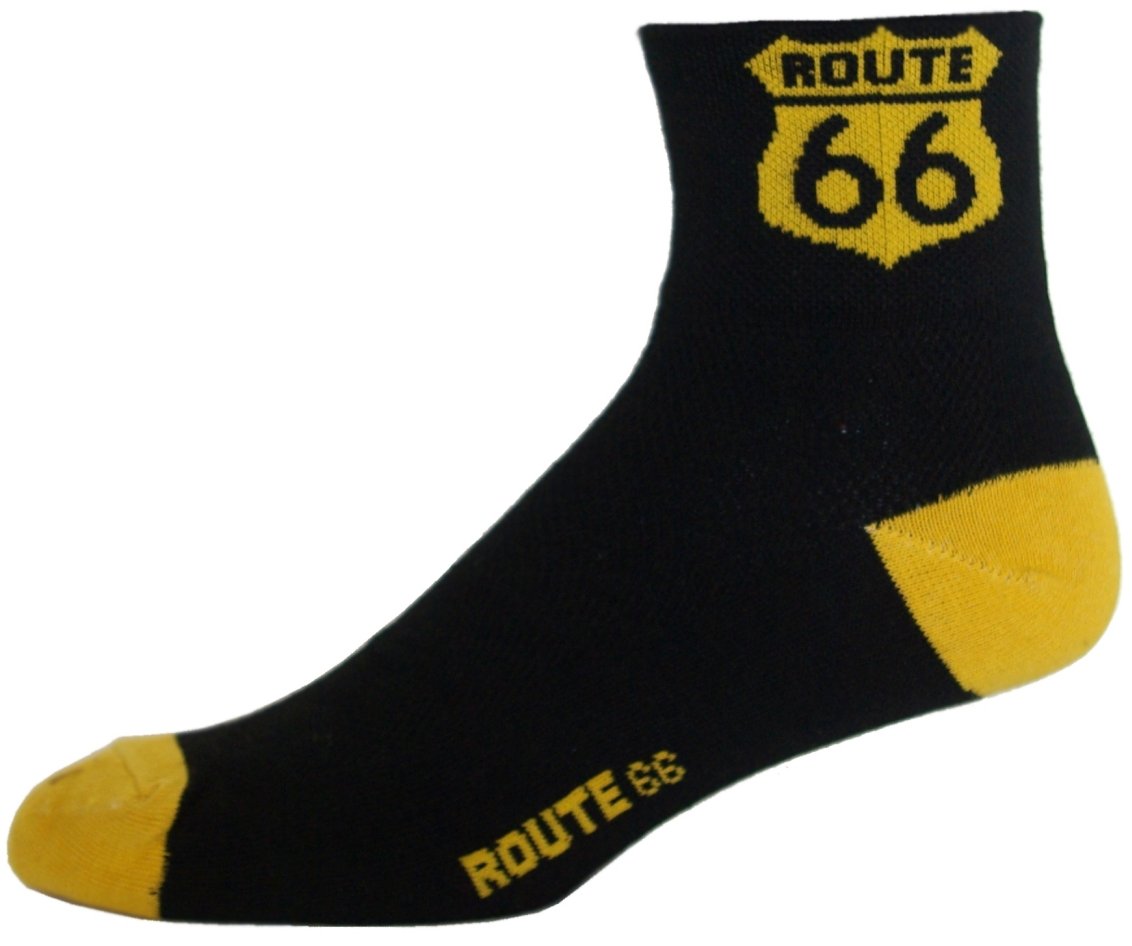
|
Adventure Cycling Association map Transamerica Route Section 6Map Features Adventure Cycling Association developed the best cross country, loop, coastal and inland cycling routes available, with turn by turn directions, detailed navigational instructions for the tricky sections, and elevation profiles in the high country. The maps are also waterproof and sized to fit in a handlebar bag window or jersey pocket. ADVENTURE CYCLE MAP INCLUDE: Service symbols indicating the locations of campgrounds, hostels, motels, gas stations, groceries, restaurants, post offices, and bike shops Narratives with turn by turn instructions for traveling in either direction Distances given in miles and kilometers Contour lines providing a general idea of elevation gains and losses Elevation profiles in mountainous regions with major ascents and descents indicated Details about the natural history and cultural heritage along the route A weather chart providing average monthly rainfall and mean temperatures at various points along the route Large scale detail maps of urban or congested areas Summaries of riding conditions to provide information on road surfaces, traffic volumes, and areas of caution Our Online Addenda, where updates are always available and current These routes are available to you in 300 to 400 mile map sections, so you can plan anything from a weekend trip to a multi month adventure. Our routes feature the backroads of America where you can experience the communities and rural landscapes that make our country unique. We want you to see a rural America that can't be seen from the freeways. Our generous members and supporters are helping to create and maintain our legacy and gift to the nation the Adventure Cycling Route Network. THE FINER DETAILS OF ADVENTURE CYCLING MAPS Adventure Cycling Association maps are divided in a dozen 40 60 miles sections 12 a day to 1 day biking, this is an example of one of those section: Bi directional Narratives: Narratives have detailed turn by turn instructions for traveling in either direction. The number preceding each directive indicates the distance you've come since the beginning of the map panel at the matchline. The number following in parentheses is the distance in kilometers. Changes in road names and numbers are marked by stars both in the narrative and on the map panel. Locator Box: The locator box gives an idea of your progress on the map section. For an overview of the route, the Index Map shows a larger scale version of the route's location. Matchlines: Matchlines are solid pink lines on each end of the map panel intersecting the route. The narrative leads you from matchline to matchline. Once you reach the matchline, turn to the next map panel and begin following its narrative, again proceeding from the near matchline to the far matchline. Service Symbols: Symbols correspond with the service information on the text side of the map, and tell bicyclists what sort of services they will encounter along the route. These include campgrounds, bike shops, grocery stores, libraries, restaurants, post offices, hostels, motels, bed and breakfasts, and hotels. Elevation Profiles: Elevation profiles indicate major ascents and descents. On the Lewis Clark Trail maps as shown here, the profile is attached to each map panel. On other maps, in the mountainous regions of the country, the profile appears in one continuous panel on the text side of the map. Not all map sections have elevation profiles. North Arrow: The north arrow is not necessarily up as it is on most maps, and it changes orientation from panel to panel. This allows as many miles of the route as possible to be depicted on each map panel. End Mileages: The mileage to either end of the route section is shown at the border of each map panel. Annual Events and Points of Interest: For your information, selected museums, points of interest, and events are included, where space allows, on the map panels. Museums have a brief description of their exhibits. Annual events have a brief description and the time of year they occur. Transamerica Route Astoria, OR, to Yorktown, VA 12 map set 4,262 mi. A CLASSIC ROUTE AS OLD AS BIKECENTENNIAL Grand parks along the TransAm include Yellowstone and Grand Teton National Parks, among the best in the United States. One additional treat: because this route has been ridden by cyclists for years, many of the cafes, restaurants, and overnight accommodations along the route have kept journals consisting of entries written by cross country riders from previous years, providing you with a cyclist's history of the route. Plan on around three months give or take for the crossing. Some traverse the route quicker, but this leaves less time for sightseeing. This route can be ridden from May through September. Note that snow can occur at any time in the Rocky Mountains, and the highest pass on the route is over 11,500 feet. Although the prevailing weather patterns are from west to east, local wind patterns are more dependent on the passing pressure systems and local terrain, so you can expect your fair share of tailwinds and headwinds regardless of which direction you ride the route. Astoria, Oregon, with the hills of a miniature San Francisco, is the official beginning of the road. The view from atop the Astoria Column is well worth the uphill pedal. Stretches of beaches, outstanding state parks, steep ascents and descents, and great seafood abound during your first days of riding before you turn inland to the Willamette River Valley. Eugene is the largest city along the route, with about 140,000 residents. Other sizable cities along the way are Missoula, Montana Pueblo, Colorado and Carbondale, Illinois. The lush, green western side of the Cascade Mountains is a startling contrast to the dry terrain you'll be riding into after McKenzie Pass. The road over McKenzie Pass literally cuts through an ancient lava field and offers spectacular views of the Three Sisters and other snow capped volcanic peaks of the Cascades. Central and eastern Oregon is made up of dry, mountainous terrain and is good place to carry extra water. The National Historic Oregon Trail Interpretive Center outside of Baker City is a must see, and after completing your trip crossing the country, you'll have no trouble relating to the experiences of the early pioneers. Idaho offers a wonderful ride along the Salmon River, and some interesting Native American historic sites to visit. The route then follows the winding, scenic Lochsa River for the longest ascent of the trip around 70 miles. You'll climb up and over Lolo Pass, enter Montana, and soon reach the spur into Missoula. Missoula, a college town, provides one of the highlights of the route, featuring Adventure Cycling headquarters with its cyclist's lounge and other amenities, along with whatever services you may require in town. Beautiful panoramas and mountain passes await you in Montana. The views in Yellowstone National Park and of the Grand Tetons in Wyoming are incomparable, and memories will last a lifetime. It's worth an extra day or two off the bike to experience as much as you can of these two phenomenal national parks. Towns such as Dubois and Lander remind you that you're in the West, with their historic architecture and western style cooking. Lamont is an oasis in the windy, desolate Great Divide Basin, and serves up a mean bowl of chili. The scenery quickly changes from dry, high desert to alpine as you reach Kremmling, Colorado. Touristy Breckenridge is another great place for a layover day. You begin a long climb to crest the Continental Divide at Hoosier Pass, 11,542 feet, up amongst snow covered peaks. As the route leaves the Rockies, Royal Gorge Park offers a fun layover day, either for hanging out at the Arkansas River bridge or taking a helicopter ride over or a raft trip through the gorge. Pueblo offers bike shops and great places to eat it also serves as the halfway point of the TransAm Trail time to celebrate!. It's a good place to stock up it's the largest city you'll pass through until Carbondale, Illinois. Things start to dry out as you get into the eastern part of Colorado and cross into western Kansas. Carrying extra water is a good idea here this is hot, barren country. Right around Haswell, Colorado, you'll see your last hazy glimpse of the Rocky Mountains. Overnights at city parks in Kansas are usually accompanied by cool dips in the city swimming pools. You might have to do some early morning and early evening riding to escape the midday heat. Don't miss the pies at Cookie's in Golden City, Missouri! The flat as a pool table terrain of the Great Plains will change quickly into the roller coaster riding of Missouri. You'll find Missouri offers Civil War history, terrific canoeing at Eminence, and an excellent swimming hole Johnson's Shut Ins State Park. The route crosses the Mississippi River at Chester, Illinois, and heads into Carbondale, another fun college town. A ferry takes you across the Ohio River into Kentucky, where you'll enjoy the evening fireflies at your campsites. Kentucky offers rolling white fenced farms and woodlands until reaching Berea, the gateway to the Appalachian Mountains. A loop south of the route will take you to see Mammoth Caves National Park, the longest cave system in the world. Past Berea, you'll spend some time ascending and descending the mountains of the Appalachians, and riding part of the Blue Ridge Parkway in Virginia. The mountains turn to rolling hills and then flat riding through lush plantations and farmlands. The last stretch of the route is rich in the history of the American Revolution, with Colonial Williamsburg as the highlight. Yorktown, situated on the Chesapeake Bay, is the route's end. Terrain Some stretches of the western portion of the route follow large river valleys and can be generally flat, but expect some climbing almost every day between Astoria, Oregon, and Pueblo, Colorado. The passes throughout the Rocky Mountains are generally long but not terribly steep. The descents from these passes are, of course, a blast. Most of Kansas is beautifully flat. Missouri through the Ozarks and eastern Kentucky through the Appalachians offers short, steep climbs. The Virginia portion of the route, surprisingly, has more total elevation gain than any other state. Logistics Camping choices will vary across the country between small private campgrounds, city parks, state and national parks, national forests, and the occasional back yard. The northern Oregon coast is a heavily traveled tourist route and is flush with camping and service opportunities. From Oregon eastward through Kansas, you'll find services limited mainly to the towns along the route. Carrying extra water in the West is a good plan. Camping options improve once you're in the Rockies, but you should still expect some long stretches between accommodations and services. Options will increase near tourist areas such as Yellowstone and Grand Teton National Parks. Kansas is legendary for its hospitality. Camping in city parks is the norm through Kansas and Missouri. Food, water, and overnight accommodations are abundant from Missouri to Virginia. PLEASE REMEMBER TO CHECK FOR UPDATED ADDENDA BEFORE STARTING A TRIP!
|
| Merchant | Price | Regular Price | |
|---|---|---|---|
| CycloCamping | $6.90 | $6.90 |
Copy the following string into an e-mail to support@ultrarob.com to request support.
Mozilla/5.0 AppleWebKit/537.36 (KHTML, like Gecko; compatible; ClaudeBot/1.0; +claudebot@anthropic.com)


 Blog Feed
Blog Feed Follow on Twitter
Follow on Twitter Become a Facebook Fan
Become a Facebook Fan Flickr
Flickr MySpace
MySpace



